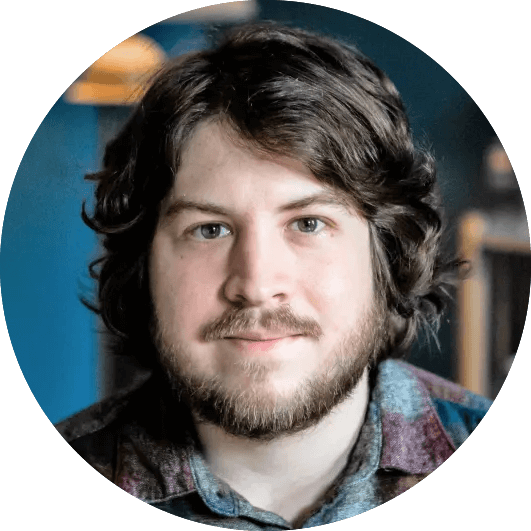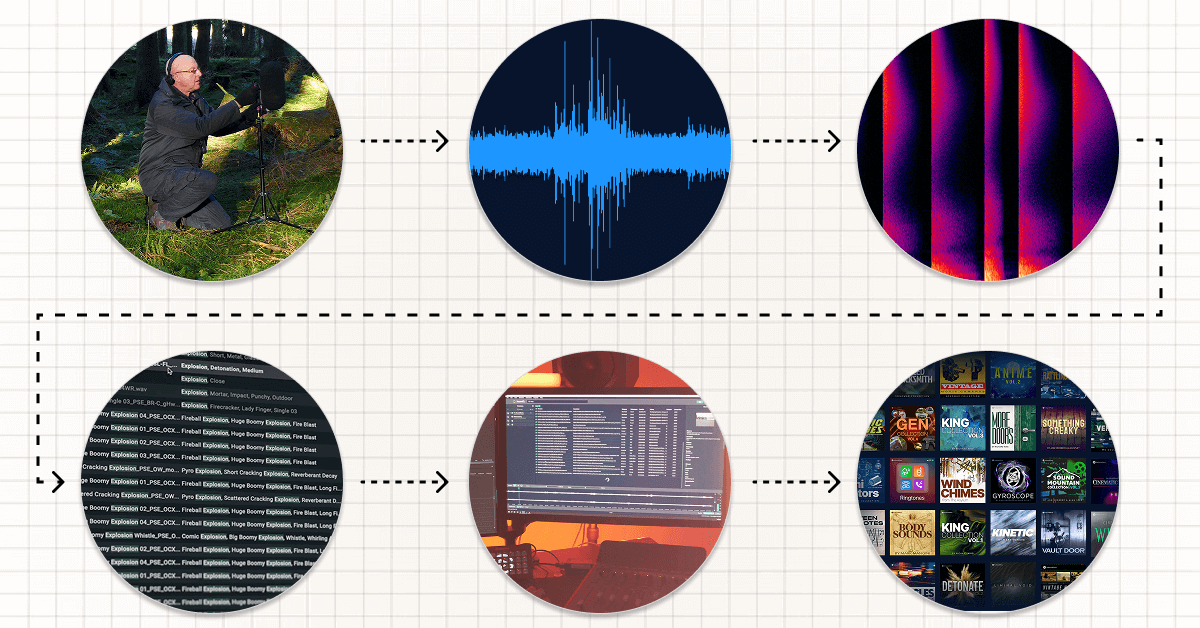Why our library development process makes a difference in your workflow.
Key takeawaysA human-centered approach Quality, creativity, and consistency Built for your workflow |
Ever wonder what goes into creating a world-class sound effects library? At Pro Sound Effects, every step of our process is designed to save you time, spark creativity, and help your projects sound incredible.
The PSE Library is made up of hundreds of individual sound effects libraries, released and refined over time. Each new release feeds into this greater collection – giving you access to a constantly evolving, professionally curated resource.
Our purpose is to help creators bring their ideas to life through sound, and it all revolves around our libraries. Brought together by a love of sound, our small, passionate team works hard to bring you top-tier sound effects that will not only inspire you, but streamline your workflow and make your job easier.
"Sound brings to life the stories we tell by driving emotion, setting context, sparking imagination and conveying meaning," says Douglas Price, CEO & Founder of Pro Sound Effects. "At PSE, we shape raw sonic material into a professional, ready-to use library designed to inspire and empower limitless creativity."
Curious how it all happens? Here’s a step-by-step walkthrough of the Pro Sound Effects library development process.
PSE Sound Artists: Chris Watson (left) & Dave Whitehead (right).
Sourcing Material
Every library released by Pro Sound Effects starts with its creator. We partner with some of the industry’s top sound artists – from Oscar®-winners like Richard King (Dune: Part Two, The Dark Knight) and Mark Mangini (Dune: Part One, Mad Max: Fury Road), to the world’s leading nature recordists like Chris Watson and Lang Elliott. Our collaborators also include creative forces across film, TV, and games – like Dave Whitehead, Martin Pinsonnault, and Watson Wu – as well as dedicated sound effects creators like Blackguard SMG (Jason Strawley & Andrew Garraway).
“We have a unique history of world-class, exclusive collaborations with the most accomplished recordists and designers in the world,” says Douglas Price. “Their dedication to sonic art and craft, combined with our proprietary library development processes, is the heart and soul of the library we have built up over 20 years.”
Some of our libraries are commissioned by PSE to fill particular needs within the sound design community, while others are curated from personal collections built up over decades. When sourcing material, we’re not just looking for top-quality sounds; we’re also looking for things you won’t find anywhere else. Even in common categories such as vehicles or animals, we like to offer different “flavors” from creators with different styles. The goal is to offer a complete palette of sound effects to make all of your ideas possible.
“When we're building new libraries,” explains our Library Manager, Daniel D’Errico, “A lot of what we're looking for has to do with filling gaps in category coverage, certain types of material that we've gotten requests for, or things we see in the market that people are excited about. Immersive audio is one area that we're looking deeply at right now.”
Once we receive a batch of sounds from an artist, the first thing we do is back up the files in their original, untouched state. In some cases, we’ll have material digitized from analog tape or transferred from obsolete formats like DAT – preserving rare and important recordings that might otherwise be lost, and making them available to creators for generations to come. After that, the editorial and curation process begins.
Initial Editorial and Curation
This stage is all about sorting through the material we’re working with, prepping it for future editing, and carefully curating it into libraries you’ll find inspiring and useful.
First, our team of sound editors performs an initial editorial pass, going through the material file by file and marking points of interest, splitting up large files, and identifying any issues that might need to be addressed. During this stage, we also give each file a tentative name and begin filling in metadata fields to describe the sounds.
At the same time, our Library Development and Marketing teams begin collaborating on curating the material, which is an ongoing process. “We realized that there were a lot of different ways that curation happens,” Dan says. “At every stage in our development model, there's some level of curation happening. It's central to the process.”

PSE Library Manager Daniel D'Errico.
If we’re working with a large batch of sound effects, we might decide to release them in multiple volumes; and if we identify groups of highly specific sounds, we might set them aside for a specialty library. Occasionally, we’ll discard certain files that don’t meet our standards or don’t fit in with the rest of the library.
“At every stage in our model, there's some level of curation happening. It's central to the process.”
Main Editorial Phase
Once we’ve sorted through a batch of sound effects and come up with a library concept, it’s time for a deeper editorial pass. Using advanced restoration tools such as iZotope RX, our editors put each file under a microscope to make sure it meets our standards. We approach this step with a “do no harm” ethos, using as light a touch as possible.
But before doing any processing, we simply listen, observe, and take notes. "Our ears are the most important editorial tool we have," says Dan. "We get an impression of each sound, noting the character and quality – it's important to have this perspective in mind before getting into the smaller editorial details." Using calibrated headphones, professional monitors, and spectral imaging, our editors then go through a checklist to identify potential issues such as unwanted background noise, errant clicks, or overmodulation (clipping). We even assess the ultrasonic spectrum to eliminate hidden unwanted noises that only become audible when pitched down.
Each sonic issue requires a specialized solution, so we train our editors to carefully assess each problem and practice surgical precision to solve it while preserving the integrity of the recording.
“If an editor heard issues when they listened through, they're already going to have in their head which tools they’ll need; which RX modules they’re going to use,” Dan explains. “If they heard clicks and pops, they know they're going to be doing some de-clicking or spectral repair. We try to have a light touch as much as possible.”
This work wouldn’t be possible without our core in-house editorial team – including Sebastian Henshaw, Huascar Holguin, Eric Mooney, and Facundo Moreno – each bringing their own ear, technical skill, and passion to every file they touch.

Spectrogram analysis in iZotope RX.
Metadata
While our editors work on a library, they continue to update the metadata to provide a complete description of the material and make it easy to find in a search. Each sound is tagged with a Category and SubCategory ID from the Universal Category System (UCS), then given additional “flavor descriptors” that tell you more about the sound.
According to Dan, the goal is to strike a balance between the literal and the aesthetic. “For every library, there's some sort of balance there,” he says. “We're going for metadata that’s practical and useful and will show up with the right search terms, but at the same time there is some extra flavor and magic.”
This step might sound boring, but it’s actually a critical part of the process. Robust metadata helps you find the sounds you need quickly, whether you search UCS terms like “AEROJet” to find jet aircraft recordings or use more natural language like “passenger plane takeoff whoosh” to find something specific.
“We’re not interested in outsourcing or automating certain types of work, like thinking about descriptions for sounds,” Dan says. “We have tools for formatting descriptions to be more consistent, but I think it's really important to have that human input. I don't want to give that up, even if AI can do it X times faster.”
Metadata also includes technical information such as sample rate, bit depth, and channel number, so you can find the exact type of file you need for any situation. Whether you’re looking for a mono 192 kHz ultrasonic recording or an Ambisonic crowd recording, metadata is key to finding it. Tools like SoundQ make this process even more efficient by allowing you to search, filter, and preview sounds using detailed metadata right within your workflow, and thanks to the UCS standard, PSE libraries are easy to search with other sound librarian tools like Basehead, Soundminer or Soundly.
“We’re not interested in outsourcing or automating certain types of work, like thinking about descriptions for sounds – it's really important to have that human input.”
Metadata filename and description in SoundQ.
Quality Control and Finalization
Quality control is integral to every stage of our process, with sound editors constantly checking each others’ work and sharing strategies to solve unique problems. At the end of the process, every library goes through one last QC pass before we finalize things like file names and metadata.
When a library is ready, one of our senior editors will perform a thorough audit to make sure the sounds themselves are up to our standards, the metadata is detailed and thorough, and everything is organized in a way that makes sense for the end user.
“As part of our training process, we really try to get new sound editors to understand exactly what we're trying to do,” says Dan. “We give them a lot of instruction because we want them to know how important it is for them to get things right on their end from the start.”
Once the editorial team is finished with their work, each library undergoes a few final checks in our proprietary ingestion pipeline, where the files are automatically backed up, analyzed for errors, and tested in our Download Manager before being readied for release.
Marketing and Release
In the final part of the process, our Library Development and Marketing teams – sometimes with additional input from the library partner – will collaborate on how to present the library in a way that communicates what it’s about, what to expect from it, and how it can show up in your workflow. This is the phase where the library’s name is finalized, product copy is written, and pricing is set. Each new library is also added to specific CORE bundle tiers.
Naming our libraries is one of the most important parts of the process, and we sometimes go through many iterations before deciding on a name that suits a library. These names can vary greatly, from straightforward descriptions like Rain by Mark Mangini to more abstract titles like Quantum Nexus that are meant to evoke the character or use-case of the sounds.
“There's good conversation that comes out during that phase, and I think it can be central to explaining what's going on with the library,” says Dan. “I really enjoy when we get to that place, because we've already done a ton of work up to that point and can now express everything we’ve absorbed through the process and communicate the understanding we have of the sounds to the marketing team in a way that’s fun.”
Whenever possible, we like to highlight the people and the process behind our libraries with Sound Artist interviews, library walkthroughs, and social media content. We believe that this extra attention does so much more than promote new products: it celebrates all the creativity and effort that goes into creating the sound effects you use.

Content collaborations with Richard King, Mark Mangini, Matt Yocum, Watson Wu, Tobias Poppe, and Artjoms Archie Cigirs.
What Does This Mean for You?
So, why do we put so much effort into library development, and what difference does it make to the end user? After all, there are plenty of places to get sound effects, right?
It all comes back to our mission of helping creators bring their ideas to life through sound. Partnering with top-tier sound artists allows us to produce inspiring and impactful libraries, diligent editing ensures consistent quality, and humanized metadata makes it possible to find the perfect sound quickly so you can stay creative.
“We put this level of care into every library because we know how much it matters,” says Douglas Price. “If we do our job right, you don’t have to think about it – your workflow just gets smoother, and your projects sound better.”
Our commitment doesn’t end when we release a library – we’re constantly looking for ways to improve our process, gathering feedback and ideas from PSE users, and staying in touch with evolving technologies and industry trends. But most importantly, we’re here to support you after your purchase. Whether you need help finding the right sounds, navigating licensing, or getting the most out of your library, our team is just a message away.
Explore our sound libraries below – and if we can help in any way, don’t hesitate to reach out to our Licensing Specialists. We’re here to help you sound better.
"If we do our job right, you don’t have to think about it – your workflow just gets smoother, and your projects sound better."





.png?width=800&height=419&name=SoundQ_Image%20(1).png)









